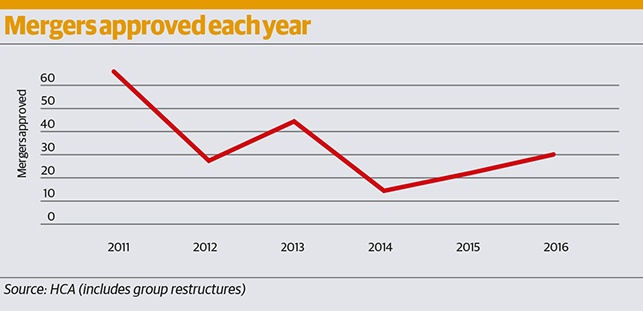You are viewing 1 of your 1 free articles
The rise of the medium-merger
While mega-mergers have stumbled, there is growing consolidation among medium-sized associations. Pete Apps investigates

Source: Elliot Kruszynski
“This time next year, there will be plans in place for eight organisations of 100,000 homes or more.” So said an unnamed housing expert, almost a year ago in the opening lines of an analysis piece in these pages about the rise in mega-mergers. It seemed a reasonable prediction back then. The idea of already giant housing associations joining forces to create behemoths, with FTSE 100-style balance sheets and Barratt Homes-size development pipelines had political backing and economic drivers aplenty.
As is often the case though, reality has proved a little more humdrum. While Affinity Sutton and Circle led the way, joining their organisations to create 125,000-home Clarion Group in November, other deals have faltered, fallen or never made it off the starting line.
Read more:
Mergers can help increase capactiy and improve services. Isos Housing Group’s Paul Fiddaman explains more of the thinking behind his organisation’s ‘medium-merger’
What has happened instead is consolidation slightly lower down the food chain. In the past four weeks alone, 11 regional or local providers have announced plans to join forces with similar-sized associations in their nearby area.
Many other conversations are understood to be under way up and down the country among various social landlords.
Resilient structure
The drivers for these mergers are varied and unique at the micro level, but the same macro concerns run through them all: the need for resilience in an increasingly uncertain economy and the financial strength to meet the political challenges over growth and efficiency.
It is tempting to draw the conclusion that this is all about surviving the rent cut - the four-year forced 1% reduction in income that wiped around 16% out of housing association business plans. But this may be a lazy assumption.
Rob Beiley, a partner at Trowers & Hamlins solicitors, says: “I genuinely don’t think it’s about rent cuts. Most associations we are seeing going in to these deals are completely sustainable in their own right and can keep a development programme in their own right.”
This chimes with the merging associations Inside Housing speaks to. They are keen to stress this was not a decision driven by concerns about viability.
But while it may not be about survival, the rent cut has played its part. Speaking to Tony Bramley, chief executive of 7,900-home Lincolnshire-based Shoreline which is merging with 4,800-home Boston Mayflower, it is clear that the two are not entirely unconnected. Lincolnshire is a comparatively low rent area, and Shoreline is a former stock-transfer landlord - two factors which mean it was at the extreme end of the impact of rent-cutting.
“I think there is no question that certainly for us the rent reduction has been a catalyst for looking seriously at it [merger],” he says. “It led to us extracting £4m out of our operating expenditure, which is about 18% of our turnover - that’s massive for us.”
In practice, this meant the death of a lot of community activities the organisation has previously prided itself on. It has axed its training and support services, reduced self-funded adaptations for disabled tenants and closed self-funded supported housing. It wants to get back into these activities, which it believes are important for its local area.
“Perhaps in contrast to what has driven the mega-mergers, which is increasing capacity, for us, it is more about protecting community-based services,” says Mr Bramley.
Where once this desire might have led a landlord such as Shoreline to partner up with a big player, perhaps as part of a federated group structure, this has changed.
“We have seen the death of the federal group structure in recent years,” says Mr Beiley. “Where previously an association had the option to go into Circle or one of the other big national players, a lot of those federal structures have been unwound. So if the local providers want to retain a local identity, they are more likely to look for a local partner.”
This reflects the comments of Orla Gallagher, chief executive of 7,500-home Housing Solutions, which is merging with 7,000-home Bracknell Forest Homes.
“We have always stayed within an hour’s drive from Maidenhead, and we are still a very locally-based housing association. There was no appetite to look at an organisation that was going to take us away from that area,” she says.
The organisation has an operating margin - the percentage of turnover left after day-to-day costs are deducted - of 44.6%.
This is equivalent to giant London landlord L&Q and better than everyone else in the top tier of large landlords, meaning Ms Gallagher’s organisation is already extremely efficient. So why merge?
“Both organisations have got development ambitions, and the local authority is very, very keen that Housing Solutions continues to provide homes in the borough,” she says. “In merging with Bracknell, we are able to do more.”
Government pressure
There is also a reputational issue driving associations to merge. Commentators on the sector, including those in government, have long expressed frustration that similar associations operate in similar areas, but duplicate services thereby adding to their costs.
Amid increasing pressure from the government to think about expenditure, regulator the Homes and Communities Agency (HCA) has been stepping up its Value for Money (VfM) regulation through in-depth assessments, and the White Paper made a clear call for housing associations to improve their efficiency.

“The organisation has been running really well - there has been great service delivery but at a cost,” says Paul Fiddaman, chief executive of 12,500-home Isos, which is merging with Cestria and Derwentside Homes to create a 23,500-home landlord.
“We were asking how we could maintain those standards and bring down costs. The conclusion was inevitable. We can look at taking out any duplication in services. By doing that, we can deliver efficiencies.”
He is clear that the housing association sector needs to align with the government’s efficiency agenda going forward if it wants to retain credibility with ministers.
“If, in a year’s time, in response to that VfM challenge, all we have done is not build as many houses, that would destroy the positive relationship we have been building up with government over the last few years,” he says.
He says that the projections suggest the merger will strip out £3m a year in expenditure, which means more than doubling its pipeline of 4,500 new homes to 11,000 over the course of its business plan.
Local suitability
There are also local factors at play. Derwentside Homes encompasses Prince Bishops, a subsidiary that carries out private rented sector development and management. Isos has no experience in this area but wants to expand, and a merger is a quicker and more efficient way of doing so compared with building up its own capacity to do the same work.
Similar factors to those described above are driving associations up and down the country to the negotiating table. Lawyers and consultants talk of a huge uptick in work on mergers at a local level.
However, we are still some way from a frenzy of completed deals. Some negotiations will never leave the confidential discussions stage and others may stumble as the details are thrashed out.
Figures provided by the HCA show 30 deals were approved in 2016 - higher than the 22 in 2015 and 13 in 2014, but well below the peak of 66 approvals in 2011 (see graph: Mergers approved each year).
While these figures need to be viewed with some caution (they include the collapsing of group structures which mean several approvals can be contained in one deal), they demonstrate that merger frenzy is yet to completely catch on, despite the bold predictions of many of those watching the sector.
What is certain, though, is that many locally-based organisations are talking to their neighbours about joining up. Should these talks continue to progress, 2017 is set to be the year of the medium-merger.








